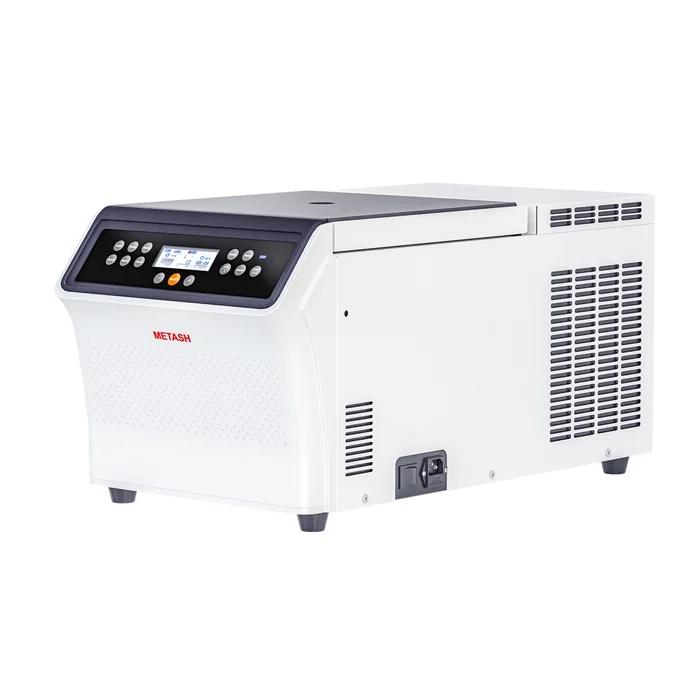Benchtop high-speed refrigerated centrifuges play a pivotal role in cell culture applications, facilitating various processes such as cell harvesting, subcellular fractionation, and sample preparation. These centrifuges are designed to operate at high speeds while maintaining low temperatures, ensuring sample integrity, and optimizing cell viability. This blog explores the technical aspects, applications, and best practices associated with using benchtop high speed refrigerated centrifuges in cell culture.
A benchtop high-speed refrigerated centrifuge is a compact yet powerful laboratory instrument designed to perform rapid centrifugation while maintaining a controlled temperature environment. Key features include:
1. High Rotational Speeds: Capable of speeds ranging from 100 to 18,000 RPM, these centrifuges generate centrifugal forces that effectively sediment cells and subcellular components.
2. Refrigeration System: An integrated refrigeration unit maintains temperatures as low as -20°C to 40°C, preventing thermal degradation of temperature-sensitive biological samples.
3. Versatile Rotor Options: Fixed-angle and swing-bucket rotors accommodate different sample volumes and applications.
4. Precise Control Mechanisms: Advanced microprocessor-controlled settings allow for accurate adjustments of speed, temperature, and time, ensuring reproducibility.

Applications of Benchtop High Speed Refrigerated Centrifuge in Cell Culture
1. Cell Harvesting
Centrifugation is the primary method for harvesting cultured cells from suspension cultures. The high-speed function allows efficient separation of cells from culture media, reducing processing time and improving yield. Maintaining low temperatures during harvesting prevents heat-induced cell damage and preserves cellular integrity.
2. Subcellular Fractionation
These centrifuges enable the fractionation of cell organelles such as nuclei, mitochondria, and lysosomes. By using differential centrifugation protocols, researchers can sequentially isolate various cellular components:
- Low-speed centrifugation: Pellets down intact cells and nuclei.
- Medium-speed centrifugation: Isolates mitochondria and lysosomes.
- High-speed centrifugation: Separates microsomes and ribosomes.
The refrigeration function is critical in preserving enzyme activity and structural integrity of subcellular components.
3. Exosome and Microvesicle Isolation
High-speed refrigerated centrifuges facilitate the isolation of extracellular vesicles (EVs), such as exosomes, from cell culture supernatants. Ultracentrifugation protocols employ successive centrifugation steps to remove cellular debris and isolate exosomes at forces exceeding 100,000g. Maintaining a low temperature prevents vesicle degradation and ensures functional integrity.
4. Protein and Nucleic Acid Precipitation
Centrifugation assists in the precipitation of proteins and nucleic acids from cell lysates and conditioned media. RNA and DNA extraction protocols utilize refrigerated centrifugation to separate nucleic acids from cellular debris while preserving molecular stability. Additionally, the centrifuge supports immunoprecipitation and co-immunoprecipitation assays used in protein interaction studies.
5. Cellular Debris Removal
During cell lysis, unwanted debris and insoluble materials must be efficiently removed. High-speed centrifugation aids in clearing lysates before downstream processing, such as Western blotting, enzyme assays, or mass spectrometry.
Best Practices for Effective Use of Benchtop High Speed Centrifuge
1. Proper Rotor Selection
- Choose an appropriate rotor type based on sample volume and application.
- Use swing-bucket rotors for density gradient separations.
- Fixed-angle rotors are ideal for pelleting cells and subcellular organelles.
2. Optimized Centrifugation Parameters
- Use recommended g-force values instead of RPM for reproducibility.
- Adjust time and temperature based on cell type and desired separation outcome.
3. Precooling and Temperature Control
- Pre-cool the centrifuge before use to stabilize temperature conditions.
- Avoid temperature fluctuations to maintain sample stability.
4. Balanced Loading
- Always balance samples by equalizing tube weights and volumes.
- Use matched centrifuge tubes to prevent rotor imbalance.
5. Regular Maintenance and Calibration
- Clean rotors and centrifuge chamber regularly.
- Schedule routine calibration and performance validation to ensure accuracy.
Conclusion
Benchtop high-speed refrigerated centrifuges are indispensable in cell culture applications, offering high efficiency in cell harvesting, subcellular fractionation, exosome isolation, and molecular biology workflows. Their ability to maintain low temperatures while operating at high speeds ensures sample integrity and reproducibility.
www.metashcorp.com
Metash
